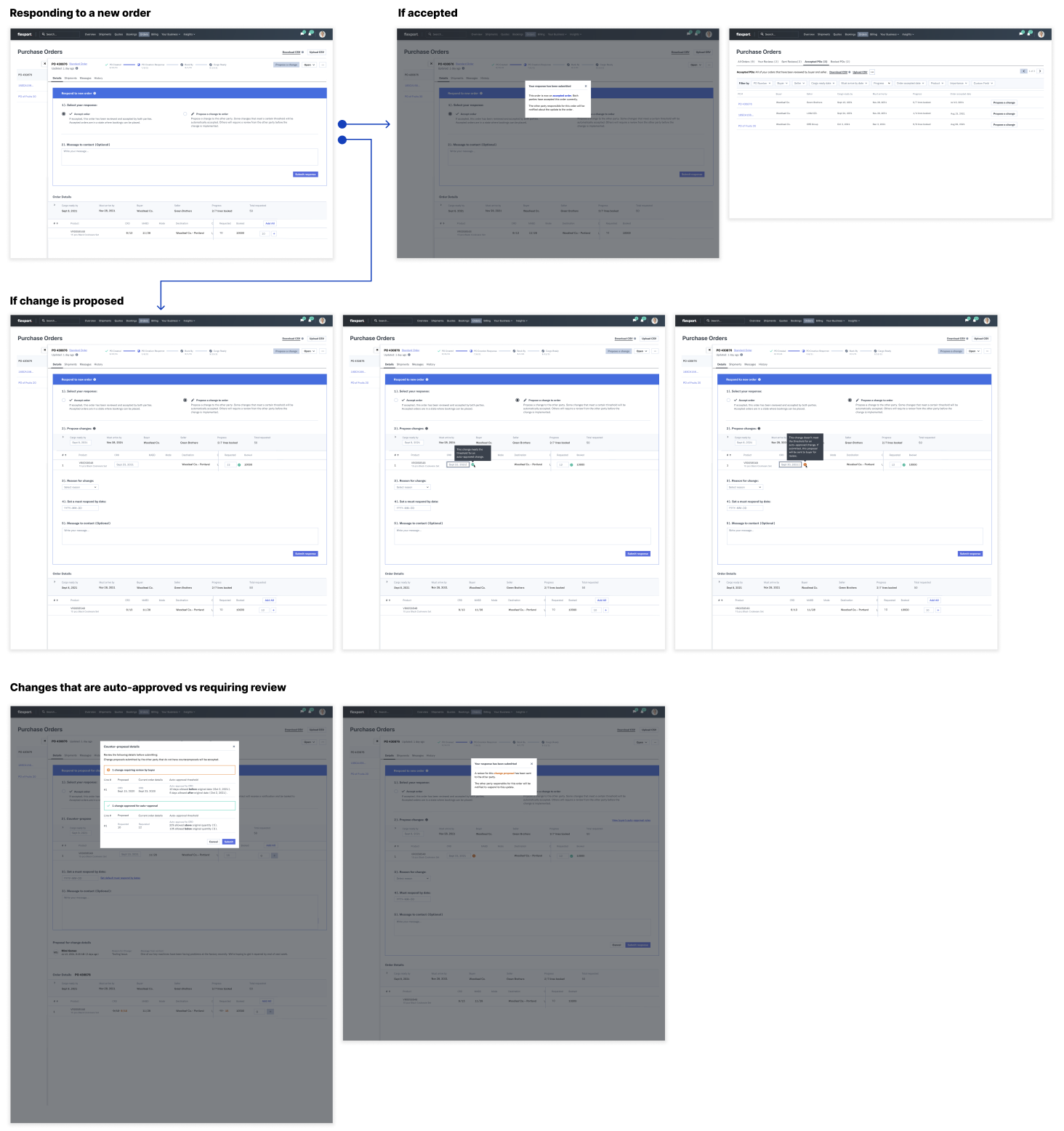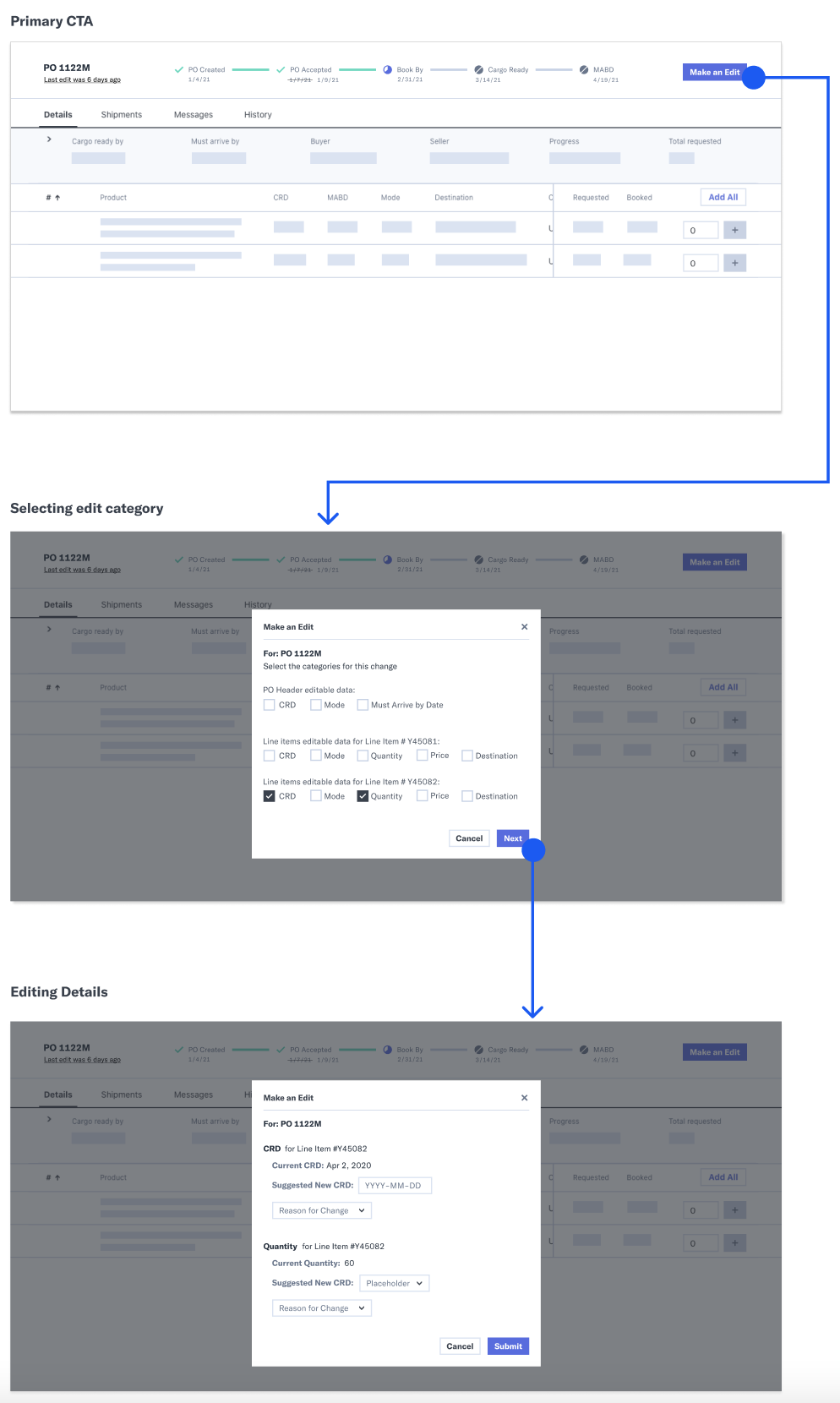
A NEW PRODUCT FEATURE
Flexport Order Negotiation
My Role: UX/UI Design, Prototyping
Platform: Desktop Web
Tools Used: Figma, Figjam
Overview
As many businesses worked quickly to adjust their supply chain needs due to the pandemic, it soon become clear that being able to make fast and flexible decisions were crucial. For many businesses, this meant tracking their purchase orders and working with their sellers to make such changes proactively.
Flexport Order Negotiation is a tool that enables businesses and their vendors to proactively communicate and make those changes together.
I was the main designer working on this new feature in Spring/Summer/Fall 2021. Together with the UX researcher, product manager, and product specialist, we worked together to research, ideate, design, and ultimately ship this new feature.
The Problem
Problem #1: Businesses often share their demand plans with vendors months in advance through a “pre-negotiation” process. As the cargo-ready-date approaches for orders, vendors will update their buyers on the progress. However, the current workflow disables vendors from making these updates to the orders themselves.
This leads to a constant and ineffective communication flow just to alert businesses to make these changes in their systems. Currently, this is all done manually through constant phone calls, virtual meetings, long email chains, and confusing changes to excel sheets.
Problem #2: When businesses upload their purchase orders to the platform, there is an expectation for sellers to place bookings for these needs. Throughout the negotiation process, the businesses have no way to keep track of the status of these orders- such as if the bookings have been placed. This puts all the responsibility on the sellers to constantly call and email their buyers to notify any updates. There is a noted lack of autonomy on the sellers’ end to make the changes to the orders themselves.
The Goals
Buyers (Businesses):
Keep track of the process of their purchase orders to ensure their demand plans are on-track.
Sellers (the vendors of the businesses):
Update purchase order details throughout the production process so that bookings are placed using accurate information.
Flexport Product:
Making sure that the purchase order workflows connect to the booking feature within our platform with accurate information.
Designs
All Orders Tab
The goals for tracking orders differs based on timeline milestones, which is organized for
users through tabs. The tasks a user must complete is differentiated as well.
Accepting a new order
Confirming change details (Bulk view)
Settings (Buyer POV)
Email Notifications
History Details
The process behind the designs:
Design Sprint
Once we completed months of exploratory research, we had key insights on the specific pain points and opportunities for our users. The next step was to make sure stakeholders were aligned on which opportunities to prioritize for this project. This synthesizing was done through a week-long design sprint. For our design sprint, the problem statement was:
How might we create a space for Buyers and their Sellers to successfully manage their purchase order workflows before a booking is placed?
Through this problem statement, we established a framework where we sought to build empathy with our 2 main user groups: Buyers and their Sellers.
A snapshot of our design sprint participants’ solutions
Early Iterations
For concept testing, our goal was to get feedback on the ideas behind the solutions. Since we had spent months of exploratory research prior and had just completed prioritizing with stakeholders- we had a good idea of which ideas we wanted to focus on for user validation.
Seller POV: Proposing a Change
Buyer POV: Making an edit
User Research
Phase 1: Buyers
Methodology
Research was done in 2 phases. Phase 1 was completed by concept testing with Flexport clients (buyers). The goal of this concept test was user validation of the design.
Through unmoderated testing, we had our research participants complete tasks and answer some scripted questions. The tasks were centered around specific features we prioritized in getting feedback on such as tracking milestones in negotiations.
For this group of users, we also conducted usability testing and evaluated more finalized designs. This was based on the feedback we received from users in concept testing.
Results
This audience found this (Purchase Order) Negotiation concept very appealing. Most could imagine using this solution to manage important milestones for the purchase orders as well as keeping their sellers accountable. Buyers were especially excited to see the automation of responding to changes in orders since constant changes to their systems manually was a big pain point.
More clarity is needed around permissions and rules behind the automation interaction, but the design concept was perceived as an efficient way to manage orders with the help of Flexport.
Phase 2: Sellers
Methodology
Phase 2 was completed by concept testing with sellers who were Flexport users. Similarly to phase 1 of the research, the goal of this concept test was validation of the design.
Through unmoderated testing, we had our research participants complete tasks and answer some scripted questions.
The main question we wanted to answer through our testing was: Would sellers find value in being able to make changes to purchase orders directly in a system managed with their buyers?
Results
This audience of sellers was very intrigued by the Order Negotiation product concept. Nearly all envisioned using it to keep buyers updated on important changes in the production timeline. The overall architecture of the product was appealing and intuitive.
Final Thoughts and Next Steps
Relationships of user groups: Through this project, I was given the opportunity to design for a unique space that directly involved with business relationships. In our research, we found that the variances in the relationship dynamics due to cultural or industry patterns was a big factor to how our solutions fit the needs of these users. For example, we found that some Buyers and their Sellers preferred to keep the current solution where most of the power to make decisions stayed with the buyer group only.
Stakeholders: This project involved working with numerous stakeholders- the most I have ever been a part of. Managing and leading the design, while also involving a large number of stakeholders was definitely one of the biggest skills I learned through this project.
Current Flexport Ecosystem: How this project fit and worked with some of the currently existing Flexport products was a caveat of this project that I will be continuing to focus in the next steps I take. This will also influence product priorities in the future possibly, as Flexport Order Management is one of the first touch-points our clients have with the platform in terms of the chronological life cycle of trade management.













